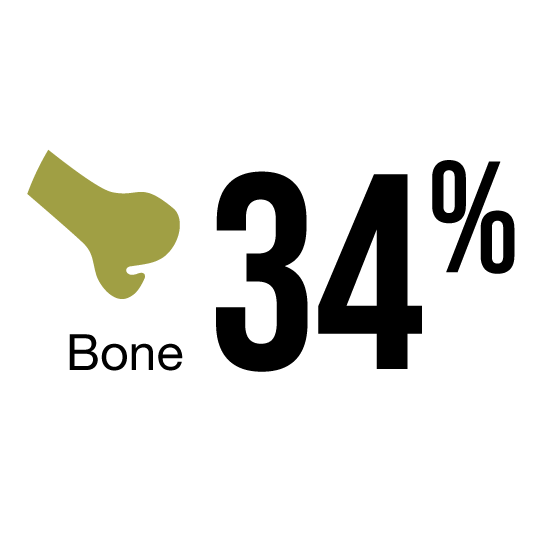Stay Informed


NRG1: It’s More Aggressive Than You Think
NRG1+ tumors are associated with aggressive features and poor outcomes1-4
A pathogenic fusion receiving increasing attention is NRG1, which has been associated with multiple poor prognostic factors.1,3
NRG1 across tumor types
NRG1 fusions have been identified across many tumor types and generally occur in the absence of other driver mutations1,5
NRG1 fusion frequency estimates
Overall (0.3%-1.7%)6,7
Enrichment
Invasive mucinous lung adenocarcinoma
(27%-31%)3A type of cancer that begins in cells that produce mucin.
Source: Radiopaedia. Accessed February 17, 2023. https://radiopaedia.org/articles/invasive-mucinous-adenocarcinoma-of-the-lung-1
Overall (0.5%-1.8%)5,8
Enrichment
KRAS wild-type pancreatic cancer (up to 6%)9
Overall (<1%)
Breast, cholangiocarcinoma, colorectal, gallbladder, sarcoma, ovarian cancers, renal cell carcinoma, etc5
Metastatic potential
Studies observed that NRG1+ tumors possess aggressive histological features associated with increased tumor growth, invasiveness, recurrence, resistance to therapy, metastasis, and worse prognosis in lung cancer.4,10,11,a
NRG1+ tumors have a higher rate of metastasis at diagnosis compared with KRAS+ tumors (67% vs 32%, respectively)10
NRG1+ tumors are 10x more likely to have concurrent intra- and extrathoracic metastases than KRAS+ tumors (50% vs 5%, respectively)10
Most common sites of NRG1+ extrathoracic metastases in IMA1



Poor outcomes and therapeutic resistance
NRG1 fusions are associated with poor outcomes and resistance to standard therapies in lung cancer4,12,13
Activity of systemic therapy in NRG1+ NSCLC1,b
ORR, %
Median PFS,
mo
(95% CI)
mo
(95% CI)
Platinum-doublet
chemotherapy (n=15)
chemotherapy (n=15)
Taxane-based
chemotherapy (n=7)
chemotherapy (n=7)
Combination chemotherapy
and immunotherapy (n=9)
and immunotherapy (n=9)
Single-agent
immunotherapy (n=5)
immunotherapy (n=5)
Targeted therapy with
kinase inhibitor (n=20)
kinase inhibitor (n=20)
13
14
0
20
25
5.8
(2.2-9.8)
(2.2-9.8)
4.0
(0.8-5.3)
(0.8-5.3)
3.3
(1.4-6.3)
(1.4-6.3)
3.6
(0.9-undefined)
(0.9-undefined)
2.8
(1.9-4.3)
(1.9-4.3)
In a retrospective global registry study of 110 patients, NRG1+ NSCLC was associated with limited response to available therapies.1
NRG1+ cancers are associated with lower OS, DFS, and PFS.1,4,11
How can you identify pathogenic gene fusions such as NRG1?
Discover the importance of RNA-based NGS

DFS, disease-free survival; IMA, invasive mucinous adenocarcinoma; NGS, next-generation sequencing; NRG1, neuregulin 1; NRG1+, neuregulin 1 fusion positive; NSCLC, non–small cell lung cancer; ORR, objective response rate; OS, overall survival; PFS, progression-free survival.
aIn a study by Chang et al (2021) at Memorial Sloan Kettering Cancer Center, histological slides from 200 IMAs were reviewed by 2 thoracic pathologists. Primary tumor size was measured pathologically in resected tumors and radiologically in unresected tumors. Presence of tumor necrosis and stromal invasion, defined by stromal desmoplasia surrounding invasive glands or nests of tumor cells, were recorded. Clinical outcomes data associated with these tumors were retrieved from electronic medical records.10 Shin et al (2016) tested 59 IMA samples obtained from patients who underwent curative surgical resection, identifying 13 SLC3A2-NRG1 fusions (27% frequency). Tumor xenografts in nude mice were generated for measuring tumor volume and weight. Proliferation, tumor volume, and weight were analyzed for cancer cells ectopically expressing SLC3A2, NRG1, and SLC3A2-NRG1.11
bPatients either diagnosed with or who developed metastatic disease during the course of their disease.
References: 1. Drilon A, Duruisseaux M, Han J-Y, et al. Clinicopathologic features and response to therapy of NRG1 fusion–driven lung cancers: the eNRGy1 Global Multicenter Registry. J Clin Oncol. 2021;39(25):2791-2802. doi:10.1200/JCO.20.03307 2. Dhanasekaran SM, Balbin OA, Chen G, et al. Transcriptome meta-analysis of lung cancer reveals recurrent aberrations in NRG1 and Hippo pathway genes. Nat Commun. 2014;5:5893. doi:10.1038/ncomms6893 3. Laskin J, Liu SV, Tolba K, et al. NRG1 fusion-driven tumors: biology, detection, and the therapeutic role of afatinib and other ErbB-targeting agents. Ann Oncol. 2020;31(12):1693-1703. doi:10.1016/j.annonc.2020.08.2335 4. Rosas D, Raez LE, Russo A, Rolfo C. Neuregulin 1 gene (NRG1). A potentially new targetable alteration for the treatment of lung cancer. Cancers (Basel). 2021;13(20):5038. doi:10.3390/cancers13205038 5. Liu SV. Plain language summary of NRG1 fusions in cancer: current knowledge and treatment with afatinib and other drugs. Future Oncol. 2022;18(26):2865-2870. doi:10.2217/fon-2022-0073 6. Drilon A, Somwar R, Mangatt BP, et al. Response to ERBB3-directed targeted therapy in NRG1-rearranged cancers. Cancer Discov. 2018;8(6):686-695. doi:10.1158/2159-8290.CD-17-1004 7. Nagasaka M, Ou SI. NRG1 and NRG2 fusion positive solid tumor malignancies: a paradigm of ligand-fusion oncogenesis. Trends Cancer. 2022;8(3):242-258. doi:10.1016/j.trecan.2021.11.003 8. Knepper TC, Kim DW, Mauer E, Ronski K, Gulhati P. Comparative analysis of the targetable landscape in KRAS-mutant and wild-type pancreatic adenocarcinoma. J Clin Oncol. 2022;40(16 suppl):4155. doi:10.1200/JCO.2022.40.16_suppl.4155 9. Jones MR, Williamson LM, Topham JT, et al. NRG1 gene fusions are recurrent, clinically actionable gene rearrangements in KRAS wild-type pancreatic ductal adenocarcinoma. Clin Cancer Res. 2019;25(15):4674-4681. doi:10.1158/1078-0432.CCR-19-0191 10. Chang JC, Offin M, Falcon C, et al. Comprehensive molecular and clinicopathologic analysis of 200 pulmonary invasive mucinous adenocarcinomas identifies distinct characteristics of molecular subtypes. Clin Cancer Res. 2021;27(14):4066-4076. doi:10.1158/1078-0432.CCR-21-0423 11. Shin DH, Lee D, Hong DW, et al. Oncogenic function and clinical implications of SLC3A2-NRG1 fusion in invasive mucinous adenocarcinoma of the lung. Oncotarget. 2016;7(43):69450-69465. doi:10.18632/oncotarget.11913 12. Benayed R, Liu SV. Neuregulin-1 (NRG1): An emerging tumor-agnostic target. Clinical Care Options: Oncology. Accessed February 7, 2023. https://www.clinicaloptions.com/oncology/programs/2021/nrg1-fusions/text-module/nrg1-text-module/page-1 13. Non-small cell lung cancer treatment (PDQ®) -patient version. National Institutes of Health, National Cancer Institute. Accessed February 7, 2023. https://www.cancer.gov/types/lung/patient/non-small-cell-lung-treatment-pdq
